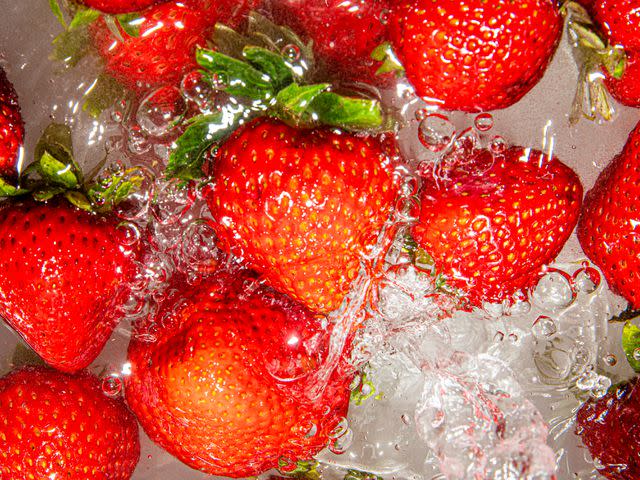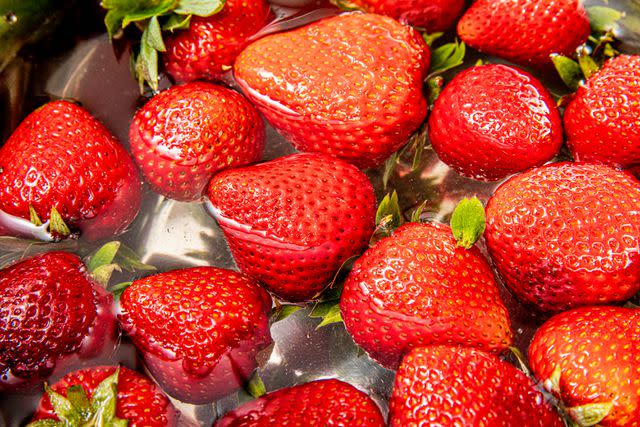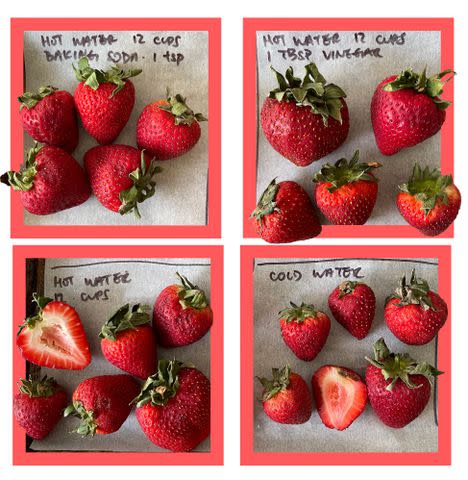How to Clean Strawberries So They Last Longer
For the longest-lasting, freshest strawberries, one cleaning and storage method worked better than all the rest.
As a young pastry cook, every summer was a fruit-filled dream that quickly became a nightmare. Faced with a bounty of ripe summer fruit, I was constantly racing against time to wash and process flats of berries before they spoiled. It was a pretty stressful job that involved a lot of cleaning. We’d fill multiple sinks with cold tap water so we could fully immerse the fruit and rinse it free of any dirt, then transfer the berries to full-sized baking sheets lined with parchment or paper towels to dry, repeating the process until every single piece of fruit had been cleaned, dried, and put away. Needless to say, any excitement I had for that first juicy strawberry quickly faded as I drowned in an unending barrage of produce.

Serious Eats / Amanda Suarez
Though I no longer work in restaurants, I still face the same dilemma each summer. Coming home from the farmers market with my weekly haul of fruit, I find myself continuing to wash, dry, and refrigerate my berries as quickly as I can. (What can I say? Old habits die hard. I have a deeply instilled fear that every minute a berry spends out of the fridge unwashed will bring it closer to its moldy downfall.)

Serious Eats / Amanda Suarez
As a cook, I was taught to treat strawberries delicately and to only wash them in cold water. But is this really the best way to clean strawberries? With berry season upon us, I decided to test out several methods commonly used to clean strawberries to see which would most successfully extend their lifespan.
Is Washing Strawberries a Good Idea?
I’ve worked for two kinds of chefs: those who believe that washing strawberries is essential, as it’s the only way you can truly get the grit and mold spores off; then there are others who are firmly against it, as they believe the berries will absorb excess water, causing the fruit to become blander in flavor and also more prone to spoilage. As Kenji has previously found, though, washing berries does not cause them to spoil faster.
“Sure, they’ll pick up a bit of moisture, but it’s entirely a surface effect,” he writes. “With careful drying—say, by spinning them in a salad spinner lined with paper towels—they weigh exactly the same after washing as they did beforehand. What’s more, washed berries stay mold-free for several days longer than their unwashed counterparts.” So go ahead and wash those berries. You’ll be doing them (and yourself!) a favor by allowing them to stay fresher for longer.
The Best Way to Wash Strawberries
As I wrote above, many insist that you should only wash strawberries in cold water. But according to both Kenji and food scientist Harold McGee, the author of On Food and Cooking, washing strawberries in hot water is the better way to go, as it destroys heat-sensitive bacteria and mold spores on the surface of strawberries.
After reading in an agricultural journal that heat was the best way to extend the life of strawberries, McGee decided to experiment with a range of temperatures and shared his findings in a 2009 article for The New York Times. He found that strawberries, raspberries, and blackberries washed in 125ºF (51ºC) water for 30 seconds “fared best,” producing just one moldy berry out of 30. “Why is it that delicate berries can survive heat high enough to kill mold and injure fingers?” McGee asked. “Probably because they have to do so in the field.”

Serious Eats / Genevieve Yam
With Kenji and McGee’s findings in mind, I decided to experiment myself. I washed berries in cold water, at 125ºF (51ºC)—the temperature that McGee recommends and is within Kenji’s recommended range of 120ºF (48ºC) and 130ºF (54ºC)—then at 109ºF (43ºC), which is the hottest my tap water gets. I also left a batch of berries unwashed.
Following Kenji’s instructions, I submerged the berries in water for 30 seconds, drained them in a colander, then spun them dry in a salad spinner lined with a triple layer of paper towels before storing them in a breathable container. I observed no significant difference between the berries washed at 125ºF and 109ºF. Though the strawberries began to look slightly withered on day five, both batches of berries washed in hot water made it a week without molding. The unwashed berries molded on day three, and the ones washed in cold water made it to day five before I spotted the first sign of mold.
Washing berries in hot water may be the most effective way to prevent spoilage, but whether it’s worth pulling out a thermometer or putting the kettle on for this is entirely up to you. Since there was barely a discernible difference between the berries washed at 125ºF and my faucet's 109ºF, I will likely just opt to use hot tap water to clean my fruit moving forward.
Other Popular Methods: Cleaning Strawberries With Vinegar or Baking Soda
After testing with just water, I experimented with two other frequently recommended methods for cleaning strawberries: a solution of water and distilled white vinegar (at a ratio of one tablespoon vinegar for every 12 cups of water) and another of water and baking soda (one tablespoon baking soda per 12 cups water). Seeing how effective hot water was in my previous tests, I decided to once again test with water at 125ºF and 109ºF by submerging the berries for 30 seconds then spinning them dry.
Both batches of berries lasted a full week without going moldy, but the ones washed in a solution of water and baking soda were noticeably softer and stodgier than those washed in a water and vinegar, which remained firm. Though the vinegar solution proved to work well—as the berries made it to day seven without molding—it wasn’t any more effective than using just hot water alone.
You certainly don’t have to go to these lengths to clean your strawberries; after all, you may very well just want to eat your berries in one sitting after nothing more than a quick rinse in a strainer, which is totally okay. But if you’d like to extend the life of your strawberries, the best way to do so is by dunking them in some hot water.
Cleaning and Storing Strawberries: Step-by-Step Instructions
Fill a large bowl with hot water (roughly 110ºF to 130ºF or 43ºC to 54ºC)
Add strawberries and submerge them, swooshing them gently to wash for 30 seconds.
Drain, picking out any berries showing damage.
Transfer to a salad spinner lined with paper towels or place them in an even layer on a tray lined with paper towels. Dry the berries by spinning them in the salad spinner or by letting them air-dry on the tray.
Transfer to a breathable container, like the one they came in, or a deli container with holes punched in it.
Refrigerate.
Read the original article on Serious Eats.

